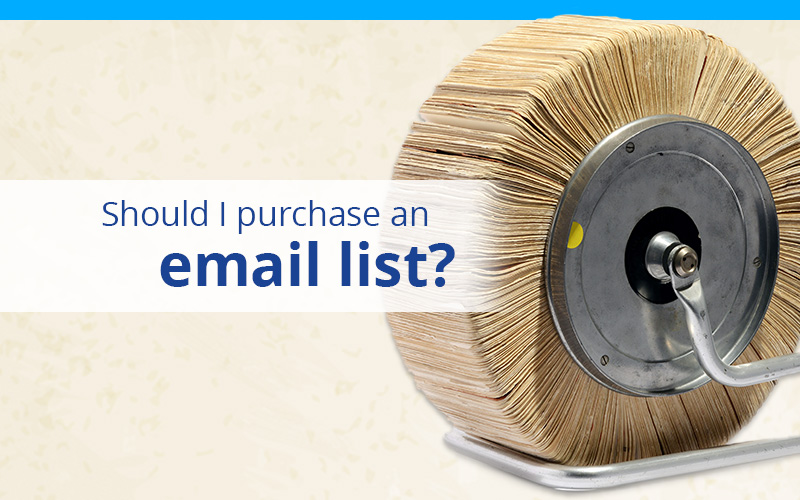It’s only a matter of time. At some point during our business relationship, every B2B and B2C client I’ve worked with has asked if they should purchase a list. I usually take a deep breath before I put the brakes on what may seem to be a great idea.
Email Lists Are Distinctly Different Than Direct Mail Lists
Marketers routinely purchase direct-mail lists, and many see a good response when mailing to them, particularly when the list contains addresses of people who match their ideal customer’s profile.
But the email inbox is much different than the postal mailbox. Consumers have distinctly different expectations about what they should find in their inbox versus their mailbox. As email was adopted by the masses, users had a more intimate relationship with their electronic inbox. A consumer email address has never been considered publicly accessible information. There are no email addresses in the white pages. And people continue to be careful about who they share their email address with to ensure the messages they receive are wanted. U.S. lawmakers supported that relationship through the CAN-SPAM Act, which insists all marketing emails contain a mechanism for unsubscribing. Our neighbors to the north took email inbox privacy one step farther with the enactment of the Canadian Anti-Spam Legislation, which requires marketers have express consent to email its citizens. Because consumers want the information they find in their email inbox, they actively curate their messages and will report spam if they receive an unsolicited email.
Between the laws and cultural norms surrounding email, it is a terrible idea to purchase a list. Here’s what happens should you decide to ignore our advice and try it anyway:
1. You won’t get good results. It is a proven fact that sending email to a purchased list is not effective. Average open rates for purchased lists are around 2 percent, according to MailChimp. Bounces and complaints are much higher than thresholds considered safe by email deliverability experts.
2. It can get you blacklisted. High bounce and complaint rates could cause internet service providers to blacklist your email, destroying your sender reputation and causing future emails — even those sent to subscribers who requested email from you — to land in the spam folder or be undelivered.
3. It could harm your brand’s reputation. Consumers are immediately distrusting of brands that send them unsolicited email. In an age where consumers can amplify their complaints on social media and company review sites, this is a risk not worth taking.
4. If the purchased list contains international email addresses, using the list could be illegal. Reputable email marketing service providers, including Katey Charles Communications, forbid the use of purchased lists on their platforms. (View our Acceptable Use Policy.)
Take a peek at these stats from MailChimp. As the percentage of email addresses on a list are “public” (purchased, rented or harvested from websites), open and click rates drop dramatically. Unsubscribes drop (because you have to open an email to unsubscribe) and complaint rates spike. Yikes!
Five More Effective Ways to Spend Your Budget
Purchased lists are appealing because they are guaranteed to increase your subscriber list size. But there are other ways to use your budget to grow your email list. Here are five tactics to try.
1. Purchase a dedicated email or an ad in a newsletter from a like-minded publication or organization. Many consumer and trade publications will allow you to purchase an ad or even a dedicated email. These emails are sent by the publication and are clearly labeled as messages from their partners. These emails are most effective when the organization sending your email is closely aligned with your own products or services. When developing creative for these types of campaigns, be sure either to make joining your email list a prominent call to action or make email collection part of your landing page forms. You’ll also want to use a link tracking extension, like bit.ly or Google tracking extensions, so you can see any web traffic that resulted from the campaign.
2. Review your email sign-up forms on your website and look for ways to improve conversion rates. Are the forms in a prominent location? Are you using a web slider to convert site visitors to email subscribers? Is your call to action clear and convincing? Is there an incentive for signing up? Have you embedded an email sign-up within your shopping cart or registration pages?
3. Gather subscribers via a pay-per-click email sign-up promotion. Design a pay-per-click ad campaign to encourage those browsing the web to sign up for your email. You could also use pay-per-click ads to drive traffic to your website. With an increase in website traffic, you should also see an increase in email sign-ups.
4. Convert your social media followers to email subscribers. Write posts and design graphics for your social media platforms that encourage followers to sign up for your email. Be sure to emphasize the benefits of an email subscription.
5. Use text-to-join to capture new subscribers at events and venues. Using text-to-join, attendees can text their email address to a special number and be added to your list. This is a great option for collecting email addresses at performances, sporting events or any other gathering of people.
Looking to grow your subscriber list? The KCC team can work with you to develop a high-quality list of subscribers. Call us today at 314-918-8088, ext. 106, or email .

